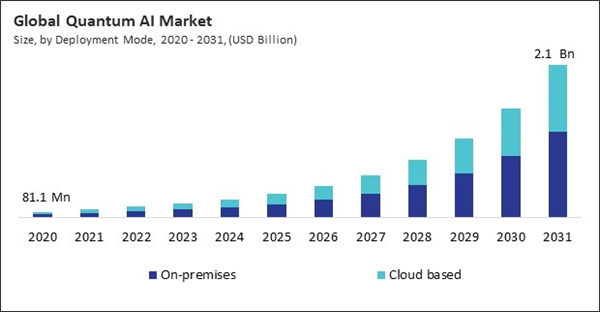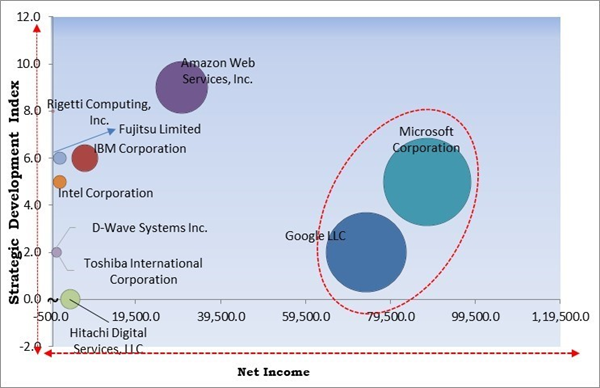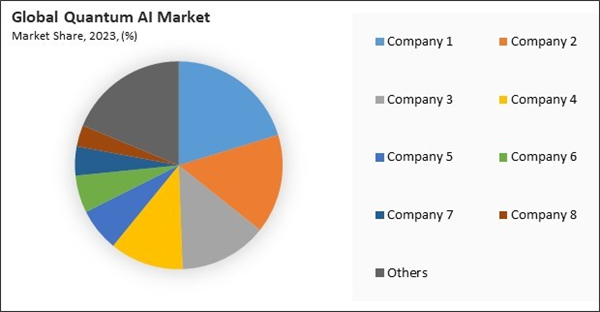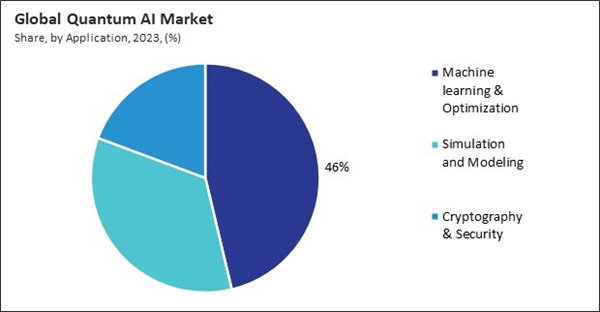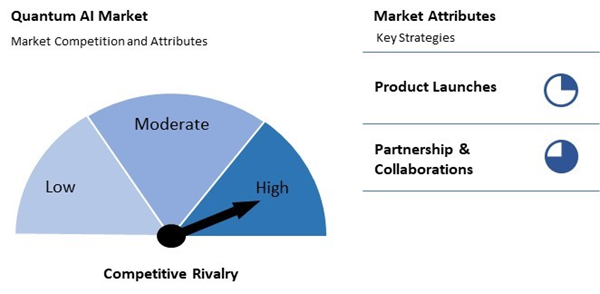The Global Quantum AI Market size is expected to reach $2.1 billion by 2031, rising at a market growth of 35.1% CAGR during the forecast period.
Europe has made significant strides in quantum research, supported by large-scale initiatives such as the European Union's Quantum Flagship program, which aims to position Europe as a leader in quantum technologies. Consequently, the European region would acquire nearly 30% of the total market share by 2031.
The major strategies followed by the market participants are Partnerships as the key developmental strategy to keep pace with the changing demands of end users. For instance, in September, 2024, Toshiba Digital Solutions Corporation formed a collaboration with SpeQtral, a prominent quantum communications technology firm, and ST Engineering, a global technology, defense, and engineering group. This agreement formalizes their strategic alliance and aims to enhance their go-to-market strategy for quantum-secure communications solutions across Singapore and Southeast Asia. The collaboration will focus on advancing quantum security solutions through joint market and business development, creating customized product and solution offerings, and exploring opportunities within the government sector. Moreover, in August, 2024, Fujitsu Limited joined hands with Center for Quantum Information and Quantum Biology at Osaka University (QIQB) on two innovative technologies designed for the space-time efficient analog rotation quantum computing architecture. These advancements are set to significantly advance the development of practical quantum computing. Fujitsu and QIQB have utilized these new technologies - one enhancing phase angle accuracy during phase rotation, and the other automating the generation of efficient qubit operation procedures - to demonstrate that a quantum computer could theoretically complete a calculation in ten hours that would take a classical computer five years.
Quantum AI has the potential to dramatically enhance the accuracy of molecular simulations, which is critical for understanding the intricate structures and behaviors of biological molecules. One of the most promising applications of this AI in healthcare is in the area of drug discovery. The pharmaceutical industry is renowned for its extensive and costly drug development cycles, which frequently require over a decade and billions of dollars to market a new drug. Thus, the growing applications of this AI in healthcare and drug discovery are driving significant advancements in medical research and, in turn, market growth.
The leading players in the market are competing with diverse innovative offerings to remain competitive in the market. The above illustration shows the percentage of revenue shared by some of the leading companies in the market. The leading players of the market are adopting various strategies in order to cater demand coming from the different industries. The key developmental strategies in the market are Partnerships & Collaborations.
The competition in the market is intense, with tech giants and startups vying for breakthroughs in quantum computing applications for AI. Companies focus on developing scalable quantum algorithms and hardware. Strategic collaborations, investments, and advancements in quantum machine learning are accelerating the competitive dynamics in this emerging field.
Europe has made significant strides in quantum research, supported by large-scale initiatives such as the European Union's Quantum Flagship program, which aims to position Europe as a leader in quantum technologies. Consequently, the European region would acquire nearly 30% of the total market share by 2031.
The major strategies followed by the market participants are Partnerships as the key developmental strategy to keep pace with the changing demands of end users. For instance, in September, 2024, Toshiba Digital Solutions Corporation formed a collaboration with SpeQtral, a prominent quantum communications technology firm, and ST Engineering, a global technology, defense, and engineering group. This agreement formalizes their strategic alliance and aims to enhance their go-to-market strategy for quantum-secure communications solutions across Singapore and Southeast Asia. The collaboration will focus on advancing quantum security solutions through joint market and business development, creating customized product and solution offerings, and exploring opportunities within the government sector. Moreover, in August, 2024, Fujitsu Limited joined hands with Center for Quantum Information and Quantum Biology at Osaka University (QIQB) on two innovative technologies designed for the space-time efficient analog rotation quantum computing architecture. These advancements are set to significantly advance the development of practical quantum computing. Fujitsu and QIQB have utilized these new technologies - one enhancing phase angle accuracy during phase rotation, and the other automating the generation of efficient qubit operation procedures - to demonstrate that a quantum computer could theoretically complete a calculation in ten hours that would take a classical computer five years.
Cardinal Matrix - Market Competition Analysis
Based on the Analysis presented in the Cardinal matrix; Microsoft Corporation and Google LLC are the forerunners in the Market. In April, 2024, Microsoft, in collaboration with Quantinuum, the world's largest integrated quantum computing company, has achieved a groundbreaking milestone in fault-tolerant quantum computing. Together, they demonstrated the most reliable logical qubits with active syndrome extraction - an accomplishment that was previously thought to be years away. This partnership marks a significant step forward for the industry, highlighting a critical milestone on the journey toward hybrid classical-quantum supercomputing, which has the potential to revolutionize scientific discovery. Companies such as Amazon Web Services, Inc., IBM Corporation and Fujitsu Limited are some of the key innovators in Market.Market Growth Factors
Governments across the globe are allocating significant resources to fund quantum research initiatives, aiming to position their countries at the forefront of this emerging field. On the private sector side, tech giants like IBM, Google, and Microsoft are in charge of developing quantum computers and these AI solutions. Hence, these concerted efforts are driving market growth.Quantum AI has the potential to dramatically enhance the accuracy of molecular simulations, which is critical for understanding the intricate structures and behaviors of biological molecules. One of the most promising applications of this AI in healthcare is in the area of drug discovery. The pharmaceutical industry is renowned for its extensive and costly drug development cycles, which frequently require over a decade and billions of dollars to market a new drug. Thus, the growing applications of this AI in healthcare and drug discovery are driving significant advancements in medical research and, in turn, market growth.
Market Restraining Factors
Developing and maintaining quantum computers requires expensive specialized infrastructure, such as cryogenic systems and vacuum chambers, essential for maintaining the delicate quantum states of qubits. Moreover, the ongoing costs of maintaining and upgrading quantum systems add to the financial burden, with companies needing to invest continuously in new hardware and software to remain competitive. Hence, the high costs of quantum technology pose a substantial obstacle to the widespread adoption and growth of this AI, limiting its potential impact across various industries.The leading players in the market are competing with diverse innovative offerings to remain competitive in the market. The above illustration shows the percentage of revenue shared by some of the leading companies in the market. The leading players of the market are adopting various strategies in order to cater demand coming from the different industries. The key developmental strategies in the market are Partnerships & Collaborations.
Driving and Restraining Factors
Drivers
- Rising investment in quantum technology
- Growing applications in healthcare and drug discovery
- Need for enhanced computational power in AI
Restraints
- High costs of quantum technology
- Limited availability of quantum talent
Opportunities
- Advances in Quantum Machine Learning (QML)
- Supportive government policies and funding
Challenges
- Long development timelines associated with Quantum AI
- Substantial cybersecurity and ethical concerns
Deployment Mode Outlook
Based on deployment mode, the market is bifurcated into on-premises and cloud based. The cloud based segment procured 42% revenue share in the market in 2023. Cloud-based AI solutions are gaining traction due to their flexibility, scalability, and accessibility. They enable organizations to capitalize on quantum computing capabilities without making considerable initial investments in hardware and infrastructure.Application Outlook
On the basis of application, the market is segmented into machine learning & optimization, cryptography & security, and simulation & modeling. The cryptography & security segment procured 19% revenue share in the market in 2023. Quantum computing's potential to revolutionize cryptography is a major driver of this segment's growth.Component Outlook
By component, the market is segmented into hardware, software, and services. The software segment procured 35% revenue share in the market in 2023. As quantum hardware continues to evolve, there is a growing need for specialized software to effectively leverage quantum computing's capabilities for AI applications.Regional Outlook
Region-wise, the market is analyzed across North America, Europe, Asia Pacific, and LAMEA. The North America segment garnered 44% revenue share in the market in 2023. This dominance is due to the region's robust technological infrastructure, significant investment in quantum research, and the leadership of major technology corporations in the development of this AI.Market Competition and Attributes
The competition in the market is intense, with tech giants and startups vying for breakthroughs in quantum computing applications for AI. Companies focus on developing scalable quantum algorithms and hardware. Strategic collaborations, investments, and advancements in quantum machine learning are accelerating the competitive dynamics in this emerging field.
Recent Strategies Deployed in the Market
- Aug-2024: Amazon Braket, the quantum computing service of Amazon Web Services (AWS), introduces the Rigetti Ankaa-2 superconducting device. This device is fully integrated with Braket's Hybrid Jobs feature, which provides a quantum-classical runtime environment and priority access throughout the execution of customer algorithms. Additionally, Ankaa-2 supports parametric compilation, allowing Braket to automatically compile and cache pre-compiled circuits for customers.
- Jul-2024: Fujitsu Australia Limited, a subsidiary of Fujitsu signed an agreement with Australian National University (ANU), to create a premier quantum research facility in Australia. This partnership will see the establishment of a dedicated center for quantum research, with plans to develop an onsite quantum computer. As part of this collaboration, ANU will design teaching and training modules centered around Fujitsu’s quantum technologies, aiming to enhance research and education in quantum computing.
- Jun-2024: IBM teamed up with Pasqal, a leading Quantum Computing company, to work on cutting-edge technologies that integrate the capabilities of quantum and conventional computers. In this collaboration, IBM and Pasqal will develop the software architecture necessary to power a quantum-centric supercomputer, combining their expertise to advance the future of computing.
- May-2024: Intel Corporation joined hands with RIKEN, Japanese research powerhouse, to push the boundaries of next-generation computing technologies, encompassing artificial intelligence (AI), high-performance computing (HPC), and silicon-based quantum computers. Their partnership will focus on advancements in supercomputing and AI technologies, as well as the development of silicon-based quantum computing and quantum simulation technologies. Additionally, Intel Foundry Services (IFS) will engage in trial work with RIKEN to further these innovations.
- Apr-2024: IBM collaborated with Rensselaer Polytechnic Institute (RPI), a private research university in Troy, New York, has officially unveiled the world's first IBM quantum computer on a university campus. IBM is proud to expand its partnership with RPI, and together, they aim to unlock new frontiers in quantum research, science, and engineering. This collaboration is poised to tackle some of the world's most complex challenges while also training the next generation of quantum experts.
List of Key Companies Profiled
- Amazon Web Services, Inc. (Amazon.com, Inc.)
- Microsoft Corporation
- Google LLC
- IBM Corporation
- Fujitsu Limited
- Intel Corporation
- Toshiba Corporation
- Rigetti Computing, Inc.
- D-Wave Systems Inc.
- Hitachi Digital Services, LLC (Hitachi Ltd.)
Market Report Segmentation
By Deployment Mode
- On-premises
- Cloud based
By Application
- Machine learning & Optimization
- Simulation and Modeling
- Cryptography & Security
By Component
- Hardware
- Software
- Services
By Geography
- North America
- US
- Canada
- Mexico
- Rest of North America
- Europe
- Germany
- UK
- France
- Russia
- Spain
- Italy
- Rest of Europe
- Asia Pacific
- China
- Japan
- India
- South Korea
- Australia
- Malaysia
- Rest of Asia Pacific
- LAMEA
- Brazil
- Argentina
- UAE
- Saudi Arabia
- South Africa
- Nigeria
- Rest of LAMEA
Table of Contents
Chapter 1. Market Scope & Methodology
Chapter 2. Market at a Glance
Chapter 3. Market Overview
Chapter 4. Competition Analysis - Global
Chapter 5. Global Quantum AI Market by Deployment Mode
Chapter 6. Global Quantum AI Market by Application
Chapter 7. Global Quantum AI Market by Component
Chapter 8. Global Quantum AI Market by Region
Chapter 9. Company Profiles
Companies Mentioned
- Amazon Web Services, Inc. (Amazon.com, Inc.)
- Microsoft Corporation
- Google LLC
- IBM Corporation
- Fujitsu Limited
- Intel Corporation
- Toshiba Corporation
- Rigetti Computing, Inc.
- D-Wave Systems Inc.
- Hitachi Digital Services, LLC (Hitachi Ltd.)
Methodology

LOADING...



